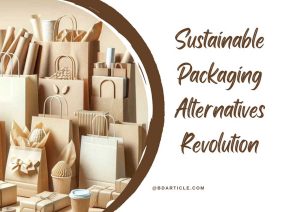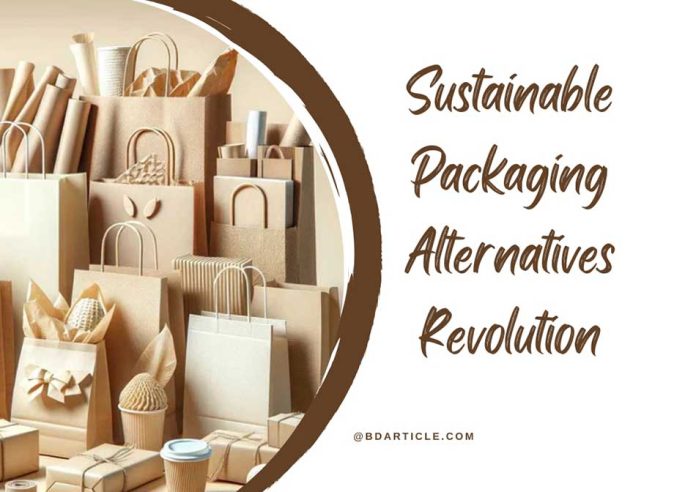Sustainable Packaging Alternatives
The quest for sustainable packaging alternatives has never been more critical. As environmental concerns reach a tipping point, businesses and consumers alike are seeking eco-friendly solutions to reduce waste and pollution. Sustainable packaging alternatives offer a revolutionary approach to traditional packaging methods, paving the way for a greener future.

Understanding the Need for Sustainable Packaging
Traditional packaging materials, particularly plastics, have a significant environmental impact. They contribute to landfill waste, ocean pollution, and resource depletion. Sustainable packaging alternatives aim to mitigate these issues by offering eco-friendly options that are biodegradable, recyclable, and made from renewable resources. These alternatives not only help protect the environment but also appeal to the growing number of eco-conscious consumers.
Types of Sustainable Packaging Alternatives
Several innovative materials and methods are emerging as viable sustainable packaging alternatives. These include biodegradable plastics, compostable packaging, and materials derived from natural sources such as mushrooms and cornstarch. Each of these options presents unique benefits and challenges, making it essential to understand their applications and limitations.
Sustainable Packaging Alternatives for Food
The food industry is one of the largest consumers of packaging materials. Sustainable packaging alternatives for food include biodegradable and compostable materials that safely encase food products while minimizing environmental impact. Examples include plant-based plastics, paper, and cardboard. These materials are designed to degrade naturally, reducing waste and pollution.
Eco Friendly Packaging Materials for Food
Eco friendly packaging materials for food are increasingly popular as businesses strive to reduce their carbon footprint. These materials include biodegradable plastics made from plant oils, cellulose-based films, and compostable packaging derived from corn and sugarcane. These alternatives not only offer a sustainable option but also maintain the quality and safety of food products.
Sustainable Packaging Alternatives for Clothes
The fashion industry is also recognizing the need for sustainable packaging alternatives for clothes. Traditional plastic garment bags and hangers are being replaced with biodegradable and recyclable options. Brands are using materials like recycled paper, organic cotton, and compostable bags to package their clothing items, reflecting their commitment to sustainability.
Mushroom Packaging
One of the most innovative sustainable alternatives to plastic packaging is mushroom packaging. This biodegradable material is made from agricultural waste and mycelium, the root structure of mushrooms. It is a durable, compostable alternative that can be molded into various shapes, making it ideal for protective packaging. Mushroom packaging decomposes quickly and enriches the soil, offering a closed-loop solution.
Cornstarch Packaging
Cornstarch packaging is another promising sustainable alternative. Derived from the natural sugars in corn, this material is biodegradable and compostable. Cornstarch packaging is used for a variety of applications, from food containers to packing peanuts. It offers a renewable, eco-friendly option that breaks down into harmless substances in the environment.
Sustainable Alternatives to Plastic Packaging
Plastic packaging is ubiquitous in modern society, but its environmental impact is significant. Sustainable alternatives to plastic packaging include materials like bioplastics, glass, metal, and paper. These alternatives reduce reliance on fossil fuels, lower carbon emissions, and decrease waste. They provide a variety of solutions that can be tailored to different industries and products.
Alternatives to Plastic Packaging for Food
Finding alternatives to plastic packaging for food is a priority for reducing plastic pollution. Options like biodegradable films, edible packaging, and reusable containers are gaining traction. These alternatives ensure food safety and freshness while being environmentally friendly. Edible packaging, for example, uses materials like seaweed and rice to create packaging that can be consumed along with the food.
Eco Friendly Packaging Examples
Several companies are leading the way with innovative eco friendly packaging examples. Brands like Lush and Patagonia have adopted sustainable materials for their packaging, setting a benchmark for others to follow. Lush uses biodegradable and recycled materials for its cosmetic products, while Patagonia employs recycled paper and compostable bags for its clothing.
The Economic Impact of Sustainable Packaging
While sustainable packaging alternatives often come with higher upfront costs, they can lead to long-term savings and benefits. Businesses that adopt eco-friendly packaging may see reduced waste management costs, increased customer loyalty, and a stronger brand reputation. Additionally, regulatory pressures and consumer demand are pushing companies toward sustainable practices, making early adoption a strategic advantage.
Regulatory Trends and Sustainable Packaging
Governments worldwide are implementing regulations to encourage the use of sustainable packaging. Policies such as plastic bans, extended producer responsibility, and recycling mandates are driving the shift towards eco-friendly materials. Staying compliant with these regulations not only helps the environment but also positions businesses as responsible and forward-thinking.
Challenges and Solutions in Sustainable Packaging
Despite the advantages, there are challenges in adopting sustainable packaging alternatives. These include higher costs, limited availability, and performance issues. However, ongoing research and innovation are addressing these challenges. Collaborations between industry, academia, and governments are essential for developing and scaling sustainable packaging solutions.
Consumer Awareness and Sustainable Packaging
Consumer awareness is a powerful driver of change in the packaging industry. As more people become conscious of their environmental impact, the demand for sustainable packaging alternatives is increasing. Businesses can leverage this trend by educating consumers about their eco-friendly practices and highlighting the benefits of sustainable packaging.
Future Trends in Sustainable Packaging
The future of sustainable packaging is promising, with continuous advancements in materials and technologies. Innovations such as nanotechnology, smart packaging, and circular economy models are expected to revolutionize the industry. These trends will not only enhance the functionality and sustainability of packaging but also create new opportunities for businesses to differentiate themselves.
Implementing Sustainable Packaging in Business Operations
For businesses looking to implement sustainable packaging, a strategic approach is essential. This includes conducting a thorough assessment of current packaging practices, identifying suitable sustainable alternatives, and engaging stakeholders throughout the supply chain. Setting clear goals, investing in employee training, and partnering with sustainable packaging suppliers can facilitate a smooth transition.
Case Studies of Successful Sustainable Packaging Implementation
Several companies have successfully implemented sustainable packaging solutions. For example, IKEA has replaced Styrofoam packaging with mushroom-based alternatives, reducing its environmental footprint. Similarly, Dell uses bamboo and mushroom packaging for its electronics, demonstrating that sustainable options can be both functional and cost-effective.
The Role of Technology in Sustainable Packaging
Technology plays a crucial role in the development and adoption of sustainable packaging alternatives. Innovations in material science, manufacturing processes, and recycling technologies are making it easier and more cost-effective to produce eco-friendly packaging. For instance, advances in bioplastics and compostable materials are expanding the range of sustainable options available to businesses.
Global Perspectives on Sustainable Packaging
Different regions of the world are approaching sustainable packaging in unique ways. In Europe, strict regulations and consumer demand are driving rapid adoption of eco-friendly materials. In Asia, countries like Japan and South Korea are investing in advanced recycling technologies. Understanding these global perspectives can provide valuable insights and best practices for businesses looking to enhance their sustainability efforts.
(Related article: Eco-friendly Travel Destinations for Blissful Journeys)
Conclusion
The sustainable packaging alternatives revolution is transforming the packaging industry. By embracing eco-friendly materials and innovative solutions, businesses can significantly reduce their environmental impact and meet the growing demand for sustainable practices. As consumer awareness and regulatory pressures continue to rise, the shift towards sustainable packaging is not just an option but a necessity for future success.
Outbound Links:
#SustainablePackagingAalternatives #SustainablePackagingAlternativesForFood #SustainablePackagingAlternativesForClothes

